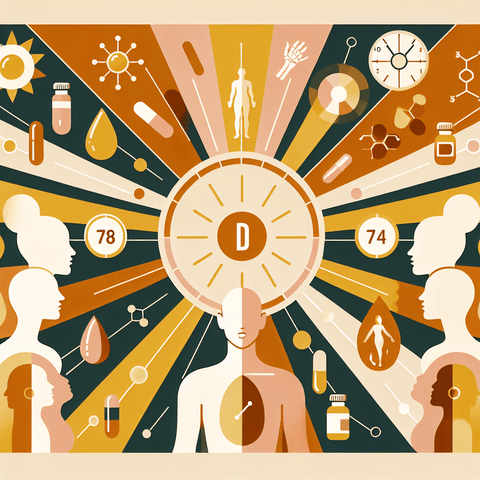Introduction
Vitamin D is often called the "sunshine vitamin" because your body produces it in response to sun exposure. However, not all skin types produce vitamin D at the same rate or efficiency when exposed to sunlight. If you've ever wondered, “what skin type needs more sun for D?” — you're not alone. This blog post unpacks the science of vitamin D synthesis, the role of melanin, the differences in requirements for different skin tones, and provides clear guidance on how to ensure you're getting enough, whether it's through sun exposure or supplementation. As vitamin D plays a critical role in immunity, bone health, and overall vitality, it's important to understand how your skin type affects your personal vitamin D needs and how you can adjust your lifestyle and routines accordingly to optimize your health.
1. Understanding Vitamin D Deficiency and Its Implications for Overall Health
Vitamin D is an essential fat-soluble vitamin that affects nearly every organ in the body. It contributes to healthy bone remodeling by regulating calcium absorption, and it's also crucial for efficient immune system functioning and mood regulation. Deficiencies in vitamin D can contribute to conditions such as osteoporosis, weakened immune responses, and even symptoms of depression, especially during seasons with minimal sunlight. The body primarily obtains vitamin D through synthesis triggered by ultraviolet B (UVB) rays from sun exposure. However, dietary intake and supplementation are also viable methods to maintain adequate levels.
There are numerous causes of vitamin D deficiency. Chief among them is inadequate sun exposure, often due to spending more time indoors, using high-SPF sunscreens, or living in higher latitudes with less year-round sun. Dietary gaps also play a role, as few foods naturally contain significant levels of vitamin D. While fatty fish and fortified products can help, even those sources may not be enough for some individuals.
One factor that dramatically influences vitamin D levels is skin pigmentation. Melanin, the pigment that gives skin its color, acts as a natural sunscreen. This means that individuals with darker skin tones may require more time in the sun to synthesize the same amount of vitamin D as those with lighter skin. Additionally, age, obesity, and certain chronic illnesses can impair the body’s ability to convert sunlight into usable vitamin D.
Because natural sunlight and dietary intake can fall short for many people, vitamin D supplements have become an essential tool for maintaining adequate blood levels. Products from the Topvitamine vitamin D supplement range offer carefully measured doses to help ensure safe and efficient support for individuals with inadequate sunlight exposure or absorption issues.
In summary, whether due to your skin type, geographic location, or lifestyle, many people require a more intentional strategy for achieving optimal vitamin D levels. Preventing deficiency through thoughtful sun exposure, diet, and supplementation can greatly influence your wellness outcomes.
2. How Skin Pigmentation Affects Vitamin D Levels and Supplementation Needs
Melanin is more than the pigment responsible for your skin color — it's also a key modulator of vitamin D synthesis. In darker skin, higher levels of melanin provide natural protection against the sun's ultraviolet rays, which is beneficial in preventing sun-related skin damage. However, this photoprotective quality can also reduce the skin’s ability to generate vitamin D effectively when exposed to sunlight.
Numerous studies have demonstrated that individuals with darker skin tones, such as those of African, South Asian, or Middle Eastern descent, typically have lower serum concentrations of 25-hydroxyvitamin D — the primary marker for vitamin D status — when compared to individuals with lighter skin living under the same sun exposure conditions. For example, a dark-skinned person may need 30-45 minutes of direct sunlight to produce the same amount of vitamin D as a light-skinned individual does in 10-15 minutes.
It is a common misconception that darker skin automatically equals vitamin D deficiency. While reduced production capability is a valid concern, many dark-skinned individuals maintain sufficient levels through dietary choices, lifestyle habits, or supplementation. Nonetheless, people with darker pigmentation are at an increased risk of developing deficiency, especially in regions with limited sunlight.
To counteract this, intentional vitamin D optimization strategies should include increased sun exposure times during safe hours, a diet rich in vitamin D-containing foods such as oily fish and egg yolks, and potentially, the addition of supplements. Options like those in the Topvitamine vitamin D line cater to this increased demand efficiently, offering various dosages tailored to different needs.
When sun exposure is limited — due to climate, season, clothing choices, or sunscreen use — supplementation becomes not just beneficial but indispensable. Consulting with a healthcare provider for appropriate dosage and monitoring is especially important for darker-skinned individuals who struggle to consistently meet their requirements naturally. By understanding the intrinsic relationship between skin pigmentation and vitamin D synthesis, one can make more informed decisions about supplementation and sun practices to avoid long-term health issues.
3. The Role of Sunlight Exposure in Natural Vitamin D Production for Different Skin Types
Sunlight is the most natural and efficient source of vitamin D for most people. Upon exposure to UVB rays, the skin begins a biosynthesis process that converts a cholesterol compound into previtamin D3, which is subsequently transformed into active vitamin D by the liver and kidneys. However, the amount of sunlight needed to produce a sufficient amount varies considerably between individuals depending on skin pigmentation, age, geographic location, and daily routines.
For individuals with lighter skin tones, as little as 10–20 minutes of mid-day sunlight exposure to the face, arms, and legs a few times per week during spring and summer months can provide adequate vitamin D synthesis. In contrast, people with darker skin may require 30 minutes to over an hour of similar exposure to produce equivalent amounts due to the protective effect of melanin.
It’s important to consider the trade-offs of UVB exposure. While sun exposure helps synthesize vitamin D, excessive sun exposure increases the risk of skin damage and skin cancers. Thus, guidelines recommend moderate, non-burning sun exposure combined with regular skin monitoring. The goal is to find a balance between acquiring sufficient vitamin D and protecting against harmful UV effects.
Where you live also plays a critical role. People living in northern latitudes receive less UVB radiation during the colder months, and darker-skinned individuals living in these areas are particularly susceptible to vitamin D deficiency. Cultural factors, such as clothing that covers most of the body or lifestyle preferences that reduce sun exposure, further compound these challenges.
To bridge these gaps, it's crucial to act deliberately. Planning outdoor time during peak UVB hours (10 a.m. to 3 p.m.), increasing skin surface exposure when possible, and considering UV index data in your area can help guide sun practices. If consistent sun exposure is not feasible, adding a vitamin D supplement like those in the Topvitamine collection provides a practical backup to maintain healthy levels without risking sun damage.
In short, understanding and adjusting your sun exposure based on your skin type and local conditions is key to maintaining optimal vitamin D levels throughout the year, especially for those predisposed to deficiencies.
4. How Vitamin D Synthesis Varies with Skin Pigmentation and Sunlight Intensity
The process of vitamin D synthesis is a biochemical cascade that begins in the skin. When exposed to UVB radiation from sunlight, 7-dehydrocholesterol, a compound present in the skin, absorbs the energy and is converted into previtamin D3. Over the next few hours, previtamin D3 thermally isomerizes into vitamin D3, which then enters circulation and undergoes hydroxylation in the liver and kidneys to become biologically active.
Melanin plays a dual role in this process. While it protects skin cells from UV damage by absorbing UV rays, it also reduces the amount of UVB that penetrates the skin, thus lowering the efficiency of vitamin D production. In comparative studies, light-skinned individuals living in temperate zones often have significantly higher serum 25(OH)D concentrations than dark-skinned individuals living in the same conditions, even considering similar outdoor activities.
Age also impacts this process. As we age, our skin's levels of 7-dehydrocholesterol decrease, impairing the first step of synthesis. Similarly, people with obesity exhibit lower levels of circulating vitamin D, possibly because vitamin D, being fat-soluble, becomes sequestered in fatty tissues and is less bioavailable.
Geographical location is another determining factor. In higher latitudes (above 37° north or south), UVB rays are too weak during the winter months to allow for vitamin D synthesis, regardless of skin type. By contrast, those living closer to the equator receive potent, consistent UVB exposure all year long — a natural advantage in maintaining healthy vitamin D levels.
Practical recommendations to optimize this synthesis across various environments include increasing sun exposure duration for darker-skinned individuals, maximizing skin surface exposure sensibly, and adjusting lifestyle behaviors to align with geographic realities. For those in less sunny climates or with limited time outdoors, adding daily vitamin D supplements like those from Topvitamine provides a reliable alternative to sun-derived vitamin D, especially during the winter.
Ultimately, recognizing how your skin type and location affect your ability to synthesize vitamin D can empower you to develop smarter routines and habits that support year-round sufficiency while avoiding the health pitfalls of deficiency.
5. Darker Skin Tones: Who Needs More Sun or Supplementation to Achieve Adequate Vitamin D?
Darker skin tones contain more melanin, which significantly reduces the skin's efficiency at producing vitamin D in response to sunlight. This evolutionary adaptation provided protection from ultraviolet radiation in equatorial regions but becomes a disadvantage in low UVB environments. Consequently, individuals with darker skin living in regions with limited sunlight exposure face an increased risk of vitamin D deficiency.
Various clinical studies have substantiated this risk. For example, research conducted in northern climates found that individuals of African or South Asian descent disproportionately had lower vitamin D levels compared to European counterparts, even when controlling for lifestyle factors such as diet and clothing habits. Symptoms of deficiency can include bone pain, muscle weakness, reduced immunity, and prolonged infections.
Clinical indicators that signal a deeper need for vitamin D include recurring colds or flu, general fatigue, mood changes (especially depression-like symptoms), bone or joint pain, and slow wound healing. For those experiencing such symptoms, a diagnostic blood test for 25(OH)D can provide clarity and help guide interventions.
For darker-skinned individuals, tailored advice includes aiming for longer sun exposure windows in safe conditions, particularly around mid-day, and ensuring sun is touching as much exposed skin as possible. However, practical challenges such as time constraints, weather, and lifestyle often mean that natural sun exposure isn't enough — especially in winter months or northern regions.
In these cases, dietary and supplemental strategies become essential. Fortified foods like cereals and plant milks can add modest amounts of vitamin D, but these rarely meet daily needs on their own. A high-quality supplement, such as available in the Topvitamine vitamin D range, can help bridge this gap efficiently and safely. Healthcare practitioners may advise a daily maintenance dose or higher doses over a brief period to correct deficiencies. Personalized dosing based on blood tests ensures optimal outcomes with minimal risk.
Periodic testing and ongoing monitoring are especially important for this demographic. Being proactive in managing vitamin D levels can help prevent the health complications that disproportionately affect people with darker skin in low-UV areas.
6. Recognizing Deficiency Symptoms and the Importance of Proper Vitamin D Intake
Knowing whether your body is receiving enough vitamin D often rests on recognizing the subtle and sometimes overlooked signs of deficiency. Although its impact spreads across numerous bodily systems, vitamin D deficiency often presents in mild ways initially, making it easy to miss until more serious conditions develop.
Common symptoms include fatigue, bone and joint pain, muscle weakness or cramps, low mood, compromised immunity, and poor wound healing. In children, a severe deficiency can lead to rickets, while in adults, it can increase the risks of osteoporosis or osteomalacia (softening of the bones). In the elderly, low levels of vitamin D are associated with falls and fractures.
Because these symptoms are also caused by other conditions, it's crucial to confirm a deficiency through a blood test measuring 25-hydroxyvitamin D. Early diagnosis allows for targeted intervention that can prevent long-term complications.
Once a deficiency is confirmed, correcting it requires a combination of lifestyle adjustments and supplementation. Sun exposure alone is often inadequate for reversing a deficiency, especially during winter months or in individuals with limited outdoor activity. Choosing appropriate vitamin D supplements, like those in the Topvitamine collection, provides a reliable method for restoring healthy levels in a controlled and scientifically supported manner.
It's also useful to pair vitamin D supplementation with other nutrients that aid absorption and effectiveness. For example, magnesium is essential for converting vitamin D into its active form. The Topvitamine magnesium collection offers synergistic support for individuals looking to optimize their vitamin D metabolism. Regular assessment and guided dosage adjustments ensure long-lasting benefits without toxicity risks.
Maintaining optimal vitamin D levels improves physical performance, boosts immunity, contributes to strong bones, and supports mood stability. Ensuring adequate midday sunlight exposure, supplementing wisely, and monitoring blood levels are all critical steps in preventing dangerous deficiencies and promoting long-term wellbeing.
7. Practical Recommendations: How to Determine Your Skin Type's Needs for Sun and Vitamin D Supplements
The first step toward optimizing your vitamin D intake is assessing your skin type using the Fitzpatrick scale, a widely accepted method that categorizes skin types from I (very fair) to VI (deeply pigmented dark skin). Once you identify your skin category, you can better determine how much sun exposure you need versus how much to rely on supplements.
Individuals with Types I–III (light to medium skin tones) typically need less sun — approximately 10–30 minutes 2 to 3 times per week, exposing significant skin areas during peak UVB hours. Those with Types IV–VI (darker skin tones) may require 30–60 minutes or even more frequent sessions depending on conditions.
Lifestyle factors such as working night shifts, wearing full-coverage clothing, or spending long hours indoors can limit sun exposure, regardless of skin color. In such cases, supplementation becomes increasingly important. Geographic factors, particularly residing in northern regions or places with long winters, further underscore the need for additional support outside of natural sunlight.
To find the right approach, consult a healthcare professional for a blood test. Based on your serum 25(OH)D levels, a personalized program, including appropriate dosage of vitamin D supplements from Topvitamine, can be established. Routine monitoring ensures that your levels stay optimal without exceeding safe limits. Combining safe sun exposure with dietary and supplemental strategies often results in the best outcomes.
Ultimately, the key to preventing vitamin D deficiency is taking control of your personal risk profile — defined by skin type, location, routine, and baseline health status — and building a balanced approach that suits your unique needs.
Conclusion
Ensuring optimal vitamin D levels is not one-size-fits-all. Your skin type plays a fundamental role in how efficiently your body produces vitamin D, particularly in response to sunlight. Those with darker skin, while naturally more protected from sun damage, often need more sun exposure or supplementation to achieve adequate levels of this essential nutrient. Coupled with other individual variables such as geography, age, lifestyle, and diet, it becomes evident that a personalized approach is key. By combining smart sun exposure with high-quality vitamin D supplements, such as those from Topvitamine, and under the guidance of a healthcare provider, you can take control of your vitamin D health and enjoy the full spectrum of benefits it provides.
Q&A Section
Q: Which skin type needs the most sun to produce vitamin D?
A: Skin Types V and VI (darker skin tones) need the most sun exposure due to high melanin content, which absorbs UVB and reduces vitamin D production.
Q: Can I rely solely on sun exposure for my vitamin D needs?
A: This depends on your skin type, lifestyle, and location. While many light-skinned individuals in sunny regions may get enough from the sun, others, particularly darker-skinned individuals in less sunny climates, likely need supplementation.
Q: What are the best supplements to take if I’m vitamin D deficient?
A: High-quality vitamin D3 supplements, like those in the Topvitamine range, are effective. Consider pairing with magnesium for improved metabolism.
Q: How do I know if I have a vitamin D deficiency?
A: Symptoms include fatigue, bone or joint pain, muscle weakness, and poor immunity. A 25(OH)D blood test confirms deficiency status.
Q: Are there risks to taking too much vitamin D?
A: Yes, excessive supplementation can lead to toxicity. Always consult a healthcare provider for dosage guidance, especially for long-term use.
Important Keywords
- vitamin D deficiency
- skin pigmentation and vitamin D
- sunlight and vitamin D
- darker skin vitamin D needs
- vitamin D supplementation
- melanin and UVB absorption
- Topvitamine vitamin D supplements
- optimal sun exposure
- safe sun practices
- Fitzpatrick skin type



